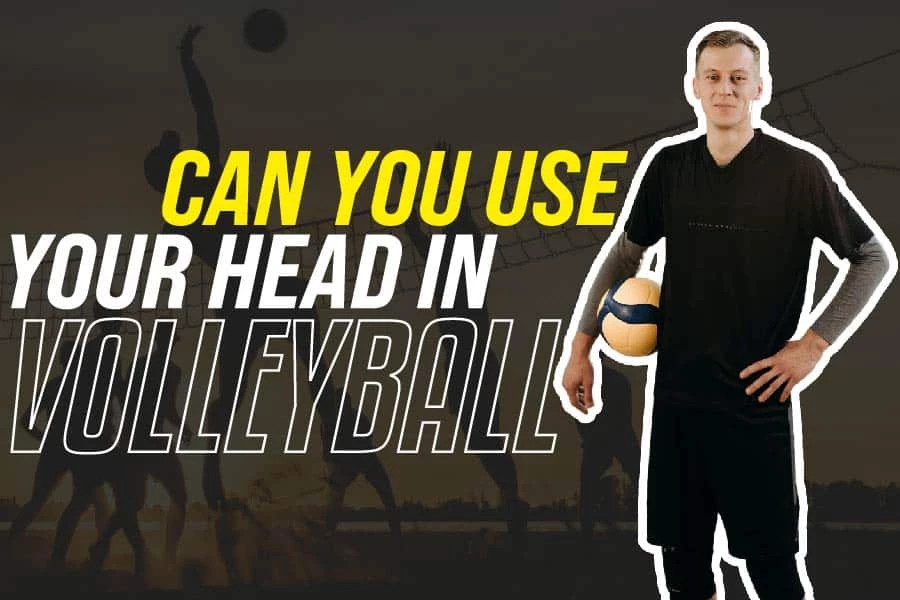When it comes to volleyball, there seem to be few rules that make it illegal for the ball to touch any part of the body. There may be some slight variations in these rules regarding whether you are playing indoors or outdoors, but generally, the ball may touch most parts of the body during play. In comparison, the ball can touch some body parts, whether by intention or accidentally. Since getting hit with the ball on the head is very common in volleyball, it is essential to understand what the law says.
So, Can You Use the Head in Volleyball
Yes, you can intentionally use your head in the ball, and it is not a foul if the ball hits your head in a volleyball game.
Using Your Head In Volleyball – What You Should Know
Though it is legal for the ball to touch the ball, whether it is intentional or not, if you intentionally use the head, you must do so correctly. If you are new to the game, you could become confused about how you are allowed to play. Lifts, doubles, and carries are why referees often blow the whistle, and you may wonder what these rules mean. These are things you should know;
1. Can You Play Volleyball with Your Head?
According to the official FIVB section 9.2, characteristics of the volleyball hit, the ball may touch any part of your body during the game. This law seems very clear because it means the ball can touch any part of your body, from your feet to the head.
The clause with this rule is that you must not hold the ball for too long. If you hold the ball on your head for too long, like juggling for a few seconds, then it becomes foul. Playing the ball with the head in volleyball happens more than you can imagine.
Players often jump over the net when the ball touches their head, especially when taking the blocking motion. While the ball may bounce over the players’ head, the referee often allows the play to continue.
2. Should the Head be Used in Playing Volleyball?
It all depends on the situation because you can hardly use your head in situations like bocking or hitting. In certain situations, using the head may be the only option of keeping the ball active. For instance, when you rely on a quick reflex and the ball comes towards your face after a block. You can headbutt the ball in these situations.
3. Are There Other Body Contacts Allowed in Volleyball?
The ball can hit just any other part of your body, including your feet, but you can’t use your feet to serve, block, or for any other active play. Similarly, the ball can hit your chest and back, but you can’t use these body parts to serve, block or hit.
Indoor Volleyball Rules- Things You Should Know
The following are rules applicable to indoor volleyball games, and most of them apply to outdoor volleyball gaming.
1. Rules for the Playing Area
Under the volleyball rules, any ball that crosses the walls and court or touches the ceiling is regarded as out of play. Similarly, a player is not permitted to enter the adjacent volleyball court to play; all team players must remain on their sides of the court.
Any low obstruction or anything perpendicular to the floor is considered out of play. In contrast, anything that is horizontal to the floor is considered in play. This rule is in place as long as the ball has not crossed the net when it hits the obstruction.
2. Players and Teams’ Duties and Rights
The referee can only be addressed by the floor captain of a volleyball team. This player is considered the team’s spokesperson. This team captain is also the one who can make requests for timeouts, especially when the ball is dead. In most volleyball matches, each time is allotted a 30-second time out per game.
Addressing an official concerning the decision they made will be sanctioned with either a yellow or red card. Committing any act to influence the referees’ actions is also considered a punishable offense. Any player making profane and vulgar remarks against opponents or officials and the spectators will also be sanctioned.
Shouting at officials or crossing the net’s vertical plane o causing any distraction against the opponent is a punishable offense, and it attracts a card. Warnings, expulsions, or disqualifications are often the major punishment for getting into physical altercations with officials, teammates, or opponents.
Yellow cards are issued mostly for minor offenses, while disqualifications often involve a second yellow or a straight card. Disqualified players are often advised to leave the court immediately and must contact the intramural director before the next match.
Improper requests from teams are often dismissed with a whistle, and persisting improper requests, especially for no reason during a game, may attract penalties.
Delaying tactics from a team are often sanctioned with a warning, which is a yellow card. Teams use several delay tactics; for instance, requesting for a second time out may be seen as delay tactics and will be properly sanctioned.
3. Laws Guiding the Team
Volleyball players are not allowed to wear jewelry while playing a game. Medical and religious medals or jewelry are also disallowed. In most cases, hair barrettes or any related item is permitted to secure players’ hair.
Armbands like sweatbands are permitted and must be worn, but hats and bandanas are not permitted in indoor volleyball. Guards, casts, and braces constructed with plastic, unyielding leather, metal, and other hard materials are not permitted. Soft supports are normally allowed, while hard parts of acceptable items must be padded with foam rubber or any other soft item.
4. Laws Regarding the Team’s Composition
Teams are expected to be ready before the start of a match, failure to obey this rule may lead to forfeiture of the match, and opponents may be awarded the victory.
A team must have a minimum of 4 players to start and should not exceed a maximum of 6 players. If only 4 players are available for the start, then the serving player will be the only player in the back row.
In case of a rally, a female player must be active before getting over the net.
5. Laws Guiding Substitution
Substituting players only happen when the ball is dead. A request must be made by the team captain to the referee. Volleyball teams are allowed unlimited substitutions of players, but the incoming and outgoing players must retain the position for which the exchange is taking place. This means that a back row player can only be substituted for another back-row player.
When it comes to open substitution, a player must be replaced by the waiting teammate. This rule often applies to the serving position.
Other Volleyball Rules Worth Mentioning
The following are some other important volleyball rules worth knowing.
Volleyball games must comprise two to three games with up to 25 points for grabs. A team must win two matches to be declared the winner.
The 6-league game may be completed with 4 players, and a team is allowed to have more women than men on a court. A server is expected to serve within 5 seconds, and a team will lose a serve if this rule is disobeyed.
Substitutions are only done when the ball is dead, but timeouts are not a requirement for substitution. An opponent must not block a serve. Players who want to interchange positions can only do so after a serve.
Passes must not be thrown, and rather, they must be properly hit or lifted. A double hit may be used for a change of direction. Backline players can spike but must remain behind the 10-feet line.
Players must avoid reaching over or touch the net. Similarly, players must not touch the centerline through a player’s foot may land on that center line; it must not cross over it. Opponents hitting the ball simultaneously over the net can still play the ball whenever it falls into their side of the court.
Intramural supervisors only have the mandate to make the final decisions on any game. All competitive volleyball games must be officiated.
Conclusion
In volleyball, there are rules guiding the legal serves, serving out of turn, and making legal hits. There are hits that are considered illegal. There are rules guiding the net and line play, while certain exceptions also exist for certain rules. There are rules guiding the interruption of plays as well as the duration of matches. Since all these rules can be quite complex, it is important to familiarize yourself with such before you get into competitive volleyball gaming. You may want to visit your local volleyball association to get a copy of these laws and their explanations.







